工作區模型登錄範例
注意
本檔涵蓋工作區模型登錄。 Azure Databricks 建議 在 Unity 目錄中使用模型。 Unity 目錄中的模型提供集中式模型控管、跨工作區存取、譜系和部署。 未來將會淘汰工作區模型登錄。
此範例說明如何使用工作區模型登錄來建置機器學習應用程式,以預測風力發電廠的每日電力輸出。 此範例示範如何:
- 使用 MLflow 追蹤和記錄模型
- 向模型登錄註冊模型
- 描述模型並製作模型版本階段轉換
- 整合已註冊的模型與生產應用程式
- 在模型登錄中搜尋和探索模型
- 封存和刪除模型
本文說明如何使用 MLflow 追蹤和 MLflow 模型登錄 UI 和 API 來執行這些步驟。
如需使用 MLflow 追蹤和登錄 API 執行所有這些步驟的筆記本,請參閱 模型登錄範例筆記本。
使用 MLflow 追蹤載入資料集、定型模型和追蹤
在模型登錄中註冊模型之前,您必須先在實驗執行期間定型和記錄模型。 本節說明如何載入風力發電廠資料集、定型模型,以及將定型執行記錄至 MLflow。
載入資料集
下列程式碼會載入資料集,其中包含美國中風力發電廠的天氣資料和電源輸出資訊。 資料集包含 、、 和 air temperature 功能,每隔六小時取樣 (一次, 08:00 一次 16:0000:00 在) ,以及數年) 的每日匯總電源輸出 (power 。 wind speedwind direction
import pandas as pd
wind_farm_data = pd.read_csv("https://github.com/dbczumar/model-registry-demo-notebook/raw/master/dataset/windfarm_data.csv", index_col=0)
def get_training_data():
training_data = pd.DataFrame(wind_farm_data["2014-01-01":"2018-01-01"])
X = training_data.drop(columns="power")
y = training_data["power"]
return X, y
def get_validation_data():
validation_data = pd.DataFrame(wind_farm_data["2018-01-01":"2019-01-01"])
X = validation_data.drop(columns="power")
y = validation_data["power"]
return X, y
def get_weather_and_forecast():
format_date = lambda pd_date : pd_date.date().strftime("%Y-%m-%d")
today = pd.Timestamp('today').normalize()
week_ago = today - pd.Timedelta(days=5)
week_later = today + pd.Timedelta(days=5)
past_power_output = pd.DataFrame(wind_farm_data)[format_date(week_ago):format_date(today)]
weather_and_forecast = pd.DataFrame(wind_farm_data)[format_date(week_ago):format_date(week_later)]
if len(weather_and_forecast) < 10:
past_power_output = pd.DataFrame(wind_farm_data).iloc[-10:-5]
weather_and_forecast = pd.DataFrame(wind_farm_data).iloc[-10:]
return weather_and_forecast.drop(columns="power"), past_power_output["power"]
定型模型
下列程式碼會使用 TensorFlow Keras 來定型神經網路,根據資料集中的天氣特徵來預測電源輸出。 MLflow 可用來追蹤模型的超參數、效能計量、原始程式碼和成品。
def train_keras_model(X, y):
import tensorflow.keras
from tensorflow.keras.models import Sequential
from tensorflow.keras.layers import Dense
model = Sequential()
model.add(Dense(100, input_shape=(X_train.shape[-1],), activation="relu", name="hidden_layer"))
model.add(Dense(1))
model.compile(loss="mse", optimizer="adam")
model.fit(X_train, y_train, epochs=100, batch_size=64, validation_split=.2)
return model
import mlflow
X_train, y_train = get_training_data()
with mlflow.start_run():
# Automatically capture the model's parameters, metrics, artifacts,
# and source code with the `autolog()` function
mlflow.tensorflow.autolog()
train_keras_model(X_train, y_train)
run_id = mlflow.active_run().info.run_id
使用 MLflow UI 註冊和管理模型
在本節中:
建立新的已註冊模型
按一下 Azure Databricks 筆記本右側提要欄中的[實驗
![] 圖示](../_static/images/icons/experiment.png) ,流覽至 [MLflow 實驗執行] 提要欄位。
,流覽至 [MLflow 實驗執行] 提要欄位。
找出對應至 TensorFlow Keras 模型定型會話的 MLflow 執行,然後按一下 [ 檢視執行詳細 資料] 圖示,在 MLflow 執行 UI 中加以開啟。
在 MLflow UI 中,向下捲動至 [ 成品] 區段,然後按一下名為 model的目錄。 按一下出現的 [ 註冊模型 ] 按鈕。

從下拉式功能表中選取 [ 建立新模型 ],然後輸入下列模型名稱:
power-forecasting-model。按一下 [註冊]。 這會註冊名為
power-forecasting-model的新模型,並建立新的模型版本:Version 1。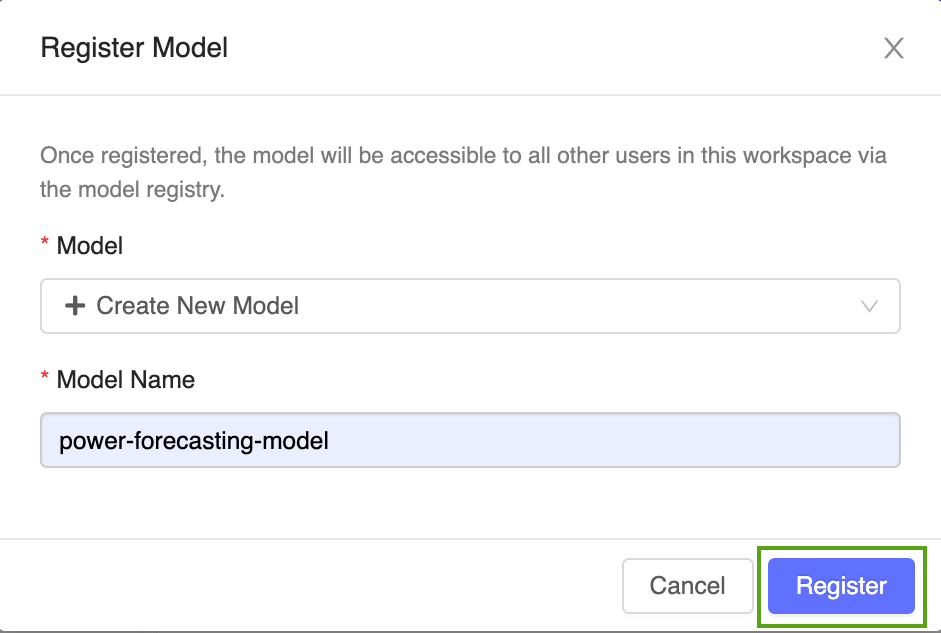
幾分鐘後,MLflow UI 會顯示新註冊模型的連結。 請遵循此連結,在 MLflow 模型登錄 UI 中開啟新的模型版本。
探索模型登錄 UI
MLflow 模型登錄 UI 中的模型版本頁面提供已註冊預測模型的相關資訊 Version 1 ,包括其作者、建立時間及其目前階段。
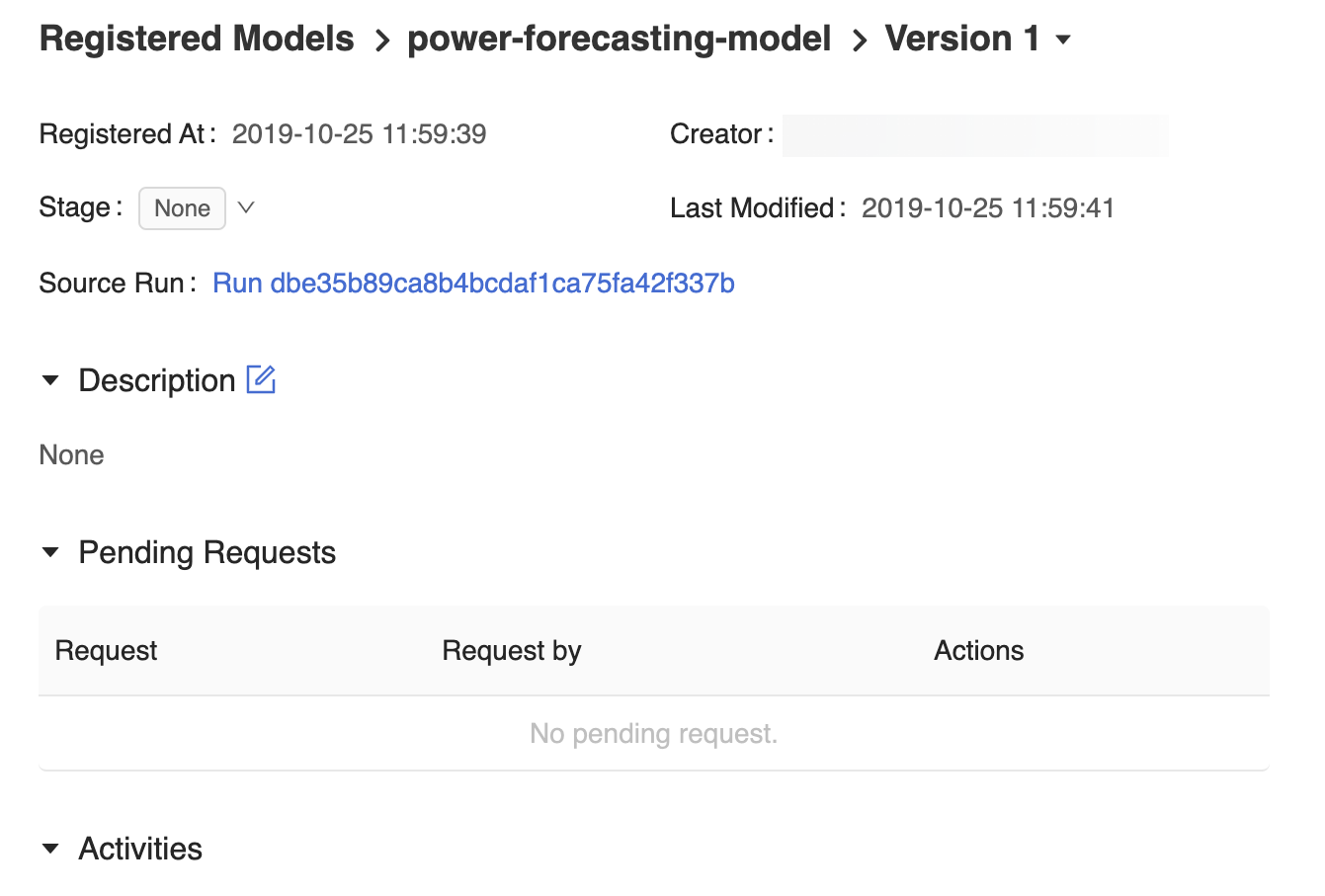
模型版本頁面也會提供 [來源執行 ] 連結,這會開啟用來在 MLflow Run UI 中建立模型的 MLflow 執行。 您可以從 MLflow 執行 UI 存取 [來源 筆記本] 連結,以檢視用來定型模型的 Azure Databricks 筆記本快照集。


若要流覽回 MLflow 模型登錄,請按一下提要欄中的 [ ![]() 模型 。
模型 。
產生的 MLflow 模型登錄首頁會顯示 Azure Databricks 工作區中所有已註冊模型的清單,包括其版本和階段。
按一下 power-forecasting-model 連結以開啟已註冊的模型頁面,其中會顯示預測模型的所有版本。
新增模型描述
您可以將描述新增至已註冊的模型和模型版本。 已註冊的模型描述適用于記錄適用于多個模型版本的資訊 (例如模型問題和資料集) 的一般概觀。 模型版本描述適用于詳細說明特定模型版本的唯一屬性 (,例如用來開發模型的方法和演算法) 。
將高階描述新增至已註冊的電源預測模型。 按一下 [
![編輯圖示] 圖示](../_static/images/icons/edit-icon.png) ,然後輸入下列描述:
,然後輸入下列描述:This model forecasts the power output of a wind farm based on weather data. The weather data consists of three features: wind speed, wind direction, and air temperature.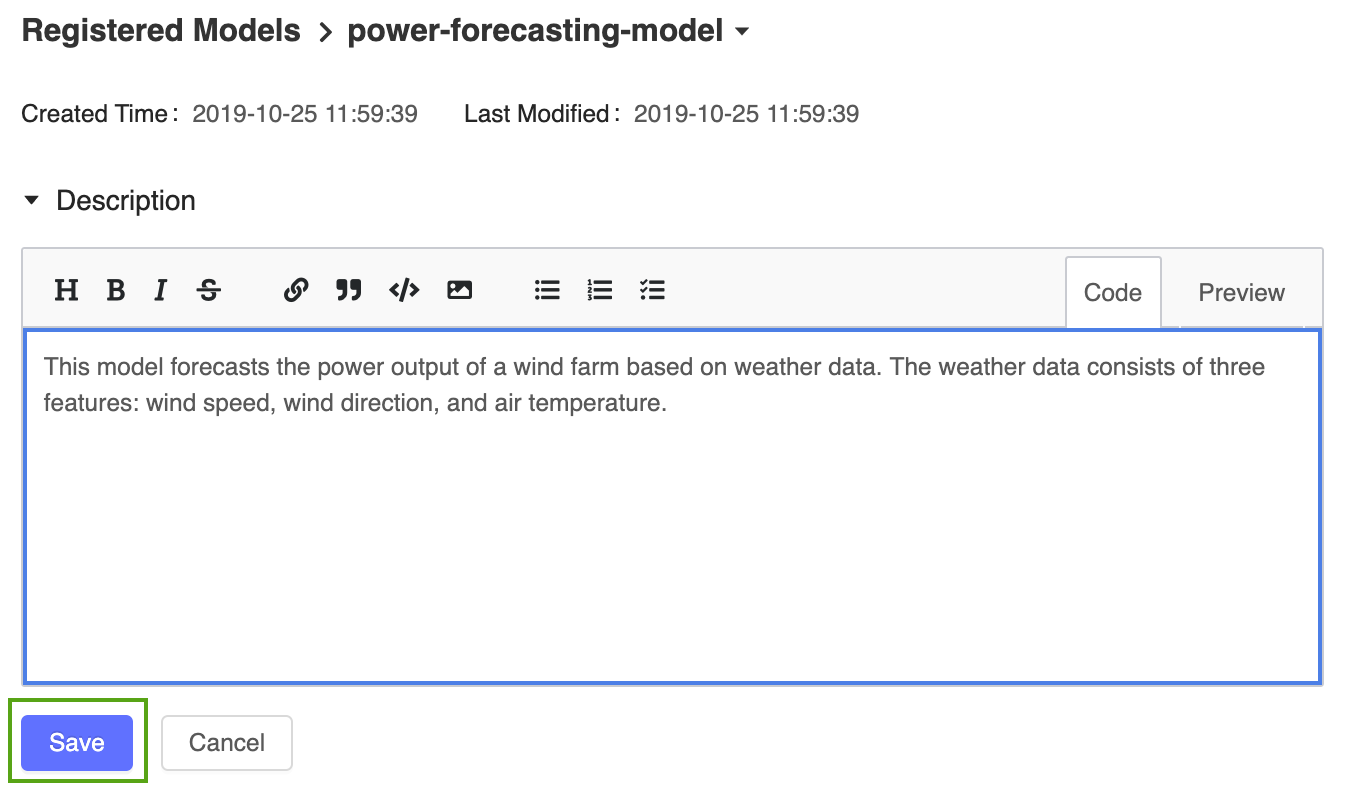
按一下 [ 儲存]。
從已註冊的模型頁面按一下 [第 1 版 ] 連結,以巡覽回模型版本頁面。
按一下 [
![編輯圖示] 圖示](../_static/images/icons/edit-icon.png) ,然後輸入下列描述:
,然後輸入下列描述:This model version was built using TensorFlow Keras. It is a feed-forward neural network with one hidden layer.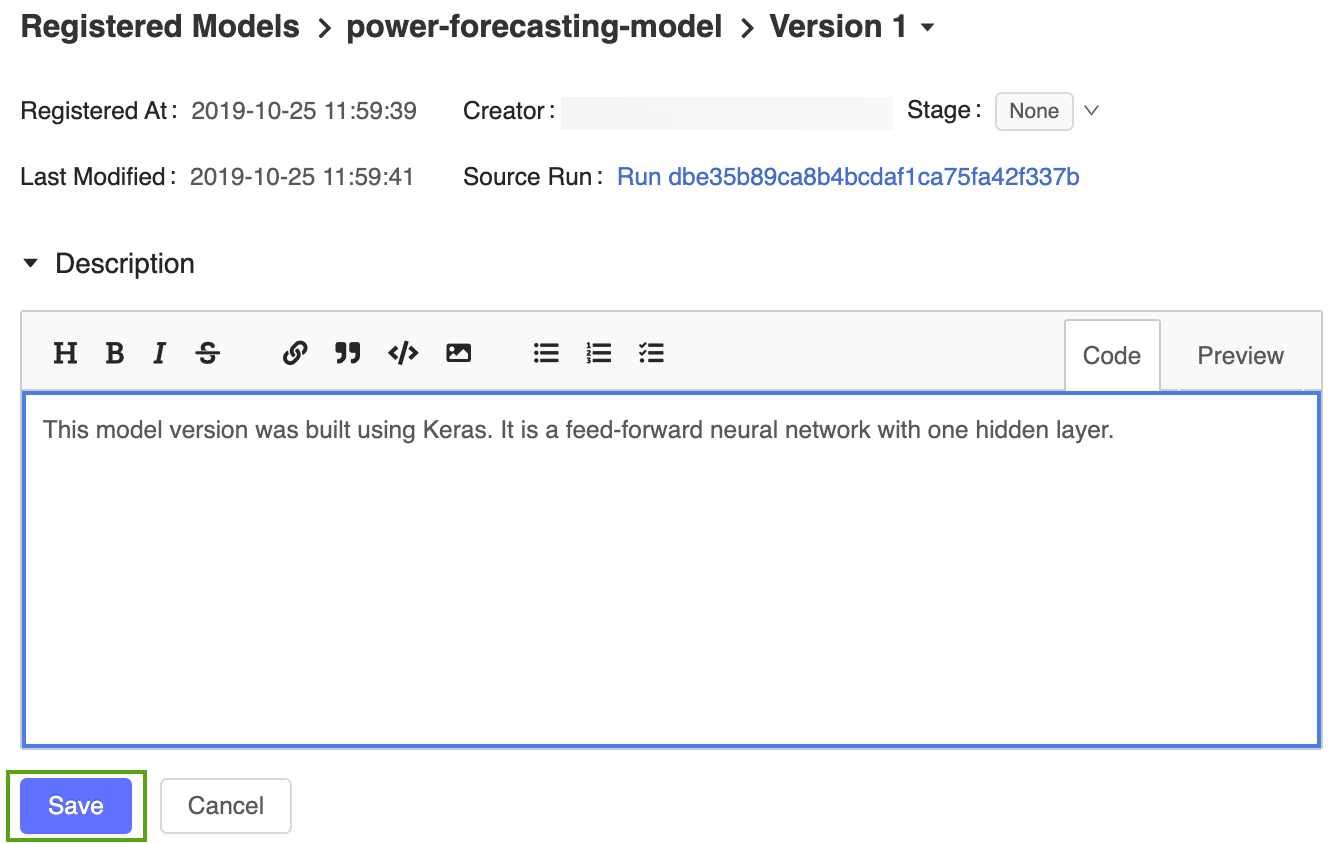
按一下 [ 儲存]。
轉換模型版本
MLflow 模型登錄會定義數個模型階段: 無、 預備、 生產及 Archived 。 每個階段都有唯一的意義。 例如, 暫存 適用于模型測試,而 生產 環境則適用于已完成測試或檢閱程式的模型,且已部署到應用程式。
按一下 [ 階段 ] 按鈕以顯示可用模型階段的清單和可用的階段轉換選項。
選取 [轉換至 - > 生產 ],然後在階段轉換確認視窗中按 [確定 ],將模型轉換為 生產環境。
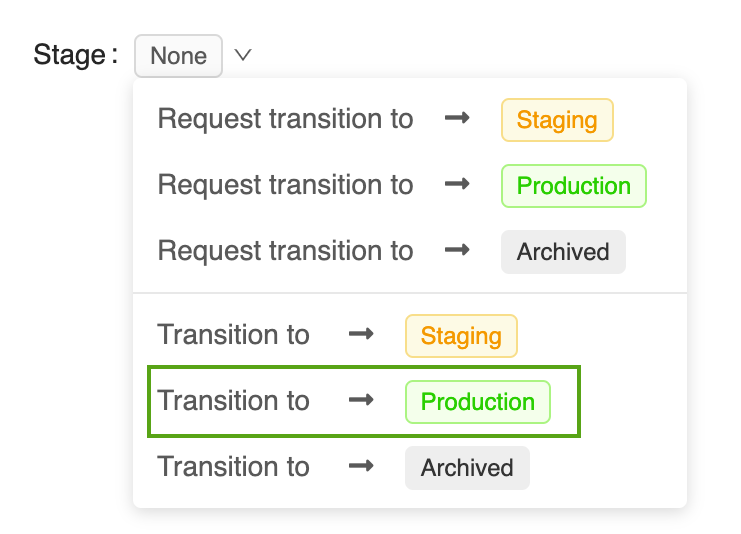
模型版本轉換至 生產環境之後,目前的階段會顯示在 UI 中,並將專案新增至活動記錄以反映轉換。


MLflow 模型登錄可讓多個模型版本共用相同的階段。 依階段參考模型時,模型登錄會使用最新的模型版本, (具有最大版本識別碼的模型版本) 。 已註冊的模型頁面會顯示特定模型的所有版本。
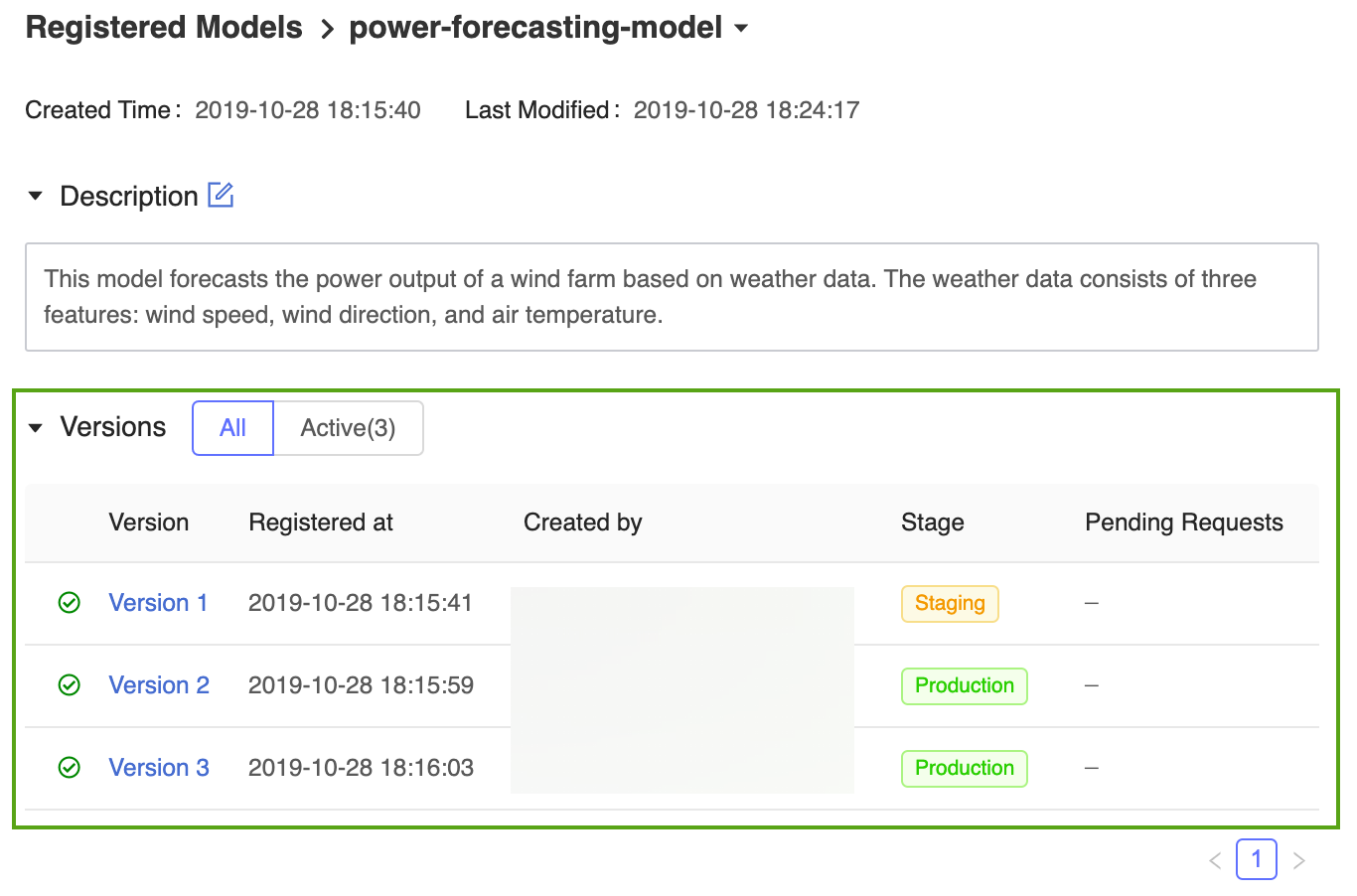
使用 MLflow API 註冊和管理模型
在本節中:
以程式設計方式定義模型的名稱
既然模型已註冊並轉換至 生產環境,您可以使用 MLflow 程式設計 API 來參考模型。 定義已註冊的模型名稱,如下所示:
model_name = "power-forecasting-model"
註冊模型
model_name = get_model_name()
import mlflow
# The default path where the MLflow autologging function stores the TensorFlow Keras model
artifact_path = "model"
model_uri = "runs:/{run_id}/{artifact_path}".format(run_id=run_id, artifact_path=artifact_path)
model_details = mlflow.register_model(model_uri=model_uri, name=model_name)
import time
from mlflow.tracking.client import MlflowClient
from mlflow.entities.model_registry.model_version_status import ModelVersionStatus
# Wait until the model is ready
def wait_until_ready(model_name, model_version):
client = MlflowClient()
for _ in range(10):
model_version_details = client.get_model_version(
name=model_name,
version=model_version,
)
status = ModelVersionStatus.from_string(model_version_details.status)
print("Model status: %s" % ModelVersionStatus.to_string(status))
if status == ModelVersionStatus.READY:
break
time.sleep(1)
wait_until_ready(model_details.name, model_details.version)
使用 API 新增模型和模型版本描述
from mlflow.tracking.client import MlflowClient
client = MlflowClient()
client.update_registered_model(
name=model_details.name,
description="This model forecasts the power output of a wind farm based on weather data. The weather data consists of three features: wind speed, wind direction, and air temperature."
)
client.update_model_version(
name=model_details.name,
version=model_details.version,
description="This model version was built using TensorFlow Keras. It is a feed-forward neural network with one hidden layer."
)
使用 API 轉換模型版本並擷取詳細資料
client.transition_model_version_stage(
name=model_details.name,
version=model_details.version,
stage='production',
)
model_version_details = client.get_model_version(
name=model_details.name,
version=model_details.version,
)
print("The current model stage is: '{stage}'".format(stage=model_version_details.current_stage))
latest_version_info = client.get_latest_versions(model_name, stages=["production"])
latest_production_version = latest_version_info[0].version
print("The latest production version of the model '%s' is '%s'." % (model_name, latest_production_version))
使用 API 載入已註冊模型的版本
MLflow 模型元件會定義函式,以從數個機器學習架構載入模型。 例如, mlflow.tensorflow.load_model() 用來載入以 MLflow 格式儲存的 TensorFlow 模型,並 mlflow.sklearn.load_model() 用來載入以 MLflow 格式儲存的 scikit-learn 模型。
這些函式可以從 MLflow 模型登錄載入模型。
import mlflow.pyfunc
model_version_uri = "models:/{model_name}/1".format(model_name=model_name)
print("Loading registered model version from URI: '{model_uri}'".format(model_uri=model_version_uri))
model_version_1 = mlflow.pyfunc.load_model(model_version_uri)
model_production_uri = "models:/{model_name}/production".format(model_name=model_name)
print("Loading registered model version from URI: '{model_uri}'".format(model_uri=model_production_uri))
model_production = mlflow.pyfunc.load_model(model_production_uri)
使用生產模型預測電源輸出
在本節中,生產模型是用來評估風力發電廠的氣象預測資料。 應用程式 forecast_power() 會從指定的階段載入最新版的預測模型,並用它來預測接下來五天的電源生產。
def plot(model_name, model_stage, model_version, power_predictions, past_power_output):
import pandas as pd
import matplotlib.dates as mdates
from matplotlib import pyplot as plt
index = power_predictions.index
fig = plt.figure(figsize=(11, 7))
ax = fig.add_subplot(111)
ax.set_xlabel("Date", size=20, labelpad=20)
ax.set_ylabel("Power\noutput\n(MW)", size=20, labelpad=60, rotation=0)
ax.tick_params(axis='both', which='major', labelsize=17)
ax.xaxis.set_major_formatter(mdates.DateFormatter('%m/%d'))
ax.plot(index[:len(past_power_output)], past_power_output, label="True", color="red", alpha=0.5, linewidth=4)
ax.plot(index, power_predictions.squeeze(), "--", label="Predicted by '%s'\nin stage '%s' (Version %d)" % (model_name, model_stage, model_version), color="blue", linewidth=3)
ax.set_ylim(ymin=0, ymax=max(3500, int(max(power_predictions.values) * 1.3)))
ax.legend(fontsize=14)
plt.title("Wind farm power output and projections", size=24, pad=20)
plt.tight_layout()
display(plt.show())
def forecast_power(model_name, model_stage):
from mlflow.tracking.client import MlflowClient
client = MlflowClient()
model_version = client.get_latest_versions(model_name, stages=[model_stage])[0].version
model_uri = "models:/{model_name}/{model_stage}".format(model_name=model_name, model_stage=model_stage)
model = mlflow.pyfunc.load_model(model_uri)
weather_data, past_power_output = get_weather_and_forecast()
power_predictions = pd.DataFrame(model.predict(weather_data))
power_predictions.index = pd.to_datetime(weather_data.index)
print(power_predictions)
plot(model_name, model_stage, int(model_version), power_predictions, past_power_output)
建立新的模型版本
傳統機器學習技術也適用于電源預測。 下列程式碼會使用 scikit-learn 定型隨機樹系模型,並透過 mlflow.sklearn.log_model() 函式向 MLflow 模型登錄進行註冊。
import mlflow.sklearn
from sklearn.ensemble import RandomForestRegressor
from sklearn.metrics import mean_squared_error
with mlflow.start_run():
n_estimators = 300
mlflow.log_param("n_estimators", n_estimators)
rand_forest = RandomForestRegressor(n_estimators=n_estimators)
rand_forest.fit(X_train, y_train)
val_x, val_y = get_validation_data()
mse = mean_squared_error(rand_forest.predict(val_x), val_y)
print("Validation MSE: %d" % mse)
mlflow.log_metric("mse", mse)
# Specify the `registered_model_name` parameter of the `mlflow.sklearn.log_model()`
# function to register the model with the MLflow Model Registry. This automatically
# creates a new model version
mlflow.sklearn.log_model(
sk_model=rand_forest,
artifact_path="sklearn-model",
registered_model_name=model_name,
)
使用 MLflow 模型登錄搜尋擷取新的模型版本識別碼
from mlflow.tracking.client import MlflowClient
client = MlflowClient()
model_version_infos = client.search_model_versions("name = '%s'" % model_name)
new_model_version = max([model_version_info.version for model_version_info in model_version_infos])
wait_until_ready(model_name, new_model_version)
將描述新增至新的模型版本
client.update_model_version(
name=model_name,
version=new_model_version,
description="This model version is a random forest containing 100 decision trees that was trained in scikit-learn."
)
將新的模型版本轉換為預備,並測試模型
將模型部署至生產應用程式之前,最好先在預備環境中進行測試。 下列程式碼會將新的模型版本轉換為 預備 版本,並評估其效能。
client.transition_model_version_stage(
name=model_name,
version=new_model_version,
stage="Staging",
)
forecast_power(model_name, "Staging")
將新的模型版本部署至生產環境
確認新模型版本在預備環境中執行良好之後,下列程式碼會將模型轉換為 生產 環境,並使用來自 預測電源輸出與生產模型 區段完全相同的應用程式程式碼來產生電源預測。
client.transition_model_version_stage(
name=model_name,
version=new_model_version,
stage="production",
)
forecast_power(model_name, "production")
現在 生產 階段有兩個預測模型的模型版本:以 Keras 模型定型的模型版本,以及 scikit-learn 中定型的版本。

注意
依階段參考模型時,MLflow 模型模型登錄會自動使用最新的生產版本。 這可讓您在不變更任何應用程式程式碼的情況下更新生產模型。
封存和刪除模型
當不再使用模型版本時,您可以封存或刪除它。 您也可以刪除整個已註冊的模型;這會移除其所有相關聯的模型版本。
Version 1電源預測模型的封存
電源預測模型的封存 Version 1 ,因為它不再使用。 您可以在 MLflow 模型登錄 UI 中或透過 MLflow API 封存模型。
MLflow UI 中的封存 Version 1
若要封存 Version 1 電源預測模型:
在 MLflow 模型登錄 UI 中開啟其對應的模型版本頁面:
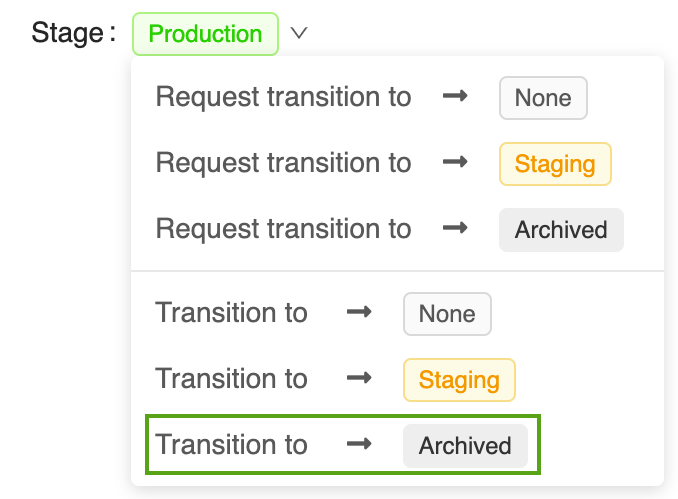
按一下 [階段] 按鈕,選取 [ 轉換至 - > 封存]:
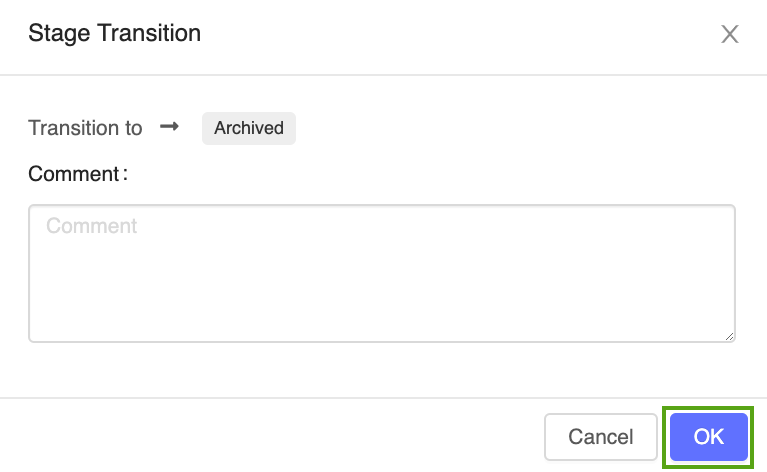
在階段轉換確認視窗中按 [確定 ]。

使用 MLflow API 封存 Version 1
下列程式碼會 MlflowClient.update_model_version() 使用 函式來封存 Version 1 電源預測模型。
from mlflow.tracking.client import MlflowClient
client = MlflowClient()
client.transition_model_version_stage(
name=model_name,
version=1,
stage="Archived",
)
刪除 Version 1 電源預測模型
您也可以使用 MLflow UI 或 MLflow API 來刪除模型版本。
警告
模型版本刪除是永久的,無法復原。
Version 1在 MLflow UI 中刪除
若要刪除 Version 1 電源預測模型:
在 MLflow 模型登錄 UI 中開啟其對應的模型版本頁面。

選取版本識別碼旁邊的下拉式箭號,然後按一下 [ 刪除]。
使用 MLflow API 刪除 Version 1
client.delete_model_version(
name=model_name,
version=1,
)
使用 MLflow API 刪除模型
您必須先將所有剩餘的模型版本階段轉換為 None 或 Archived。
from mlflow.tracking.client import MlflowClient
client = MlflowClient()
client.transition_model_version_stage(
name=model_name,
version=2,
stage="Archived",
)
client.delete_registered_model(name=model_name)